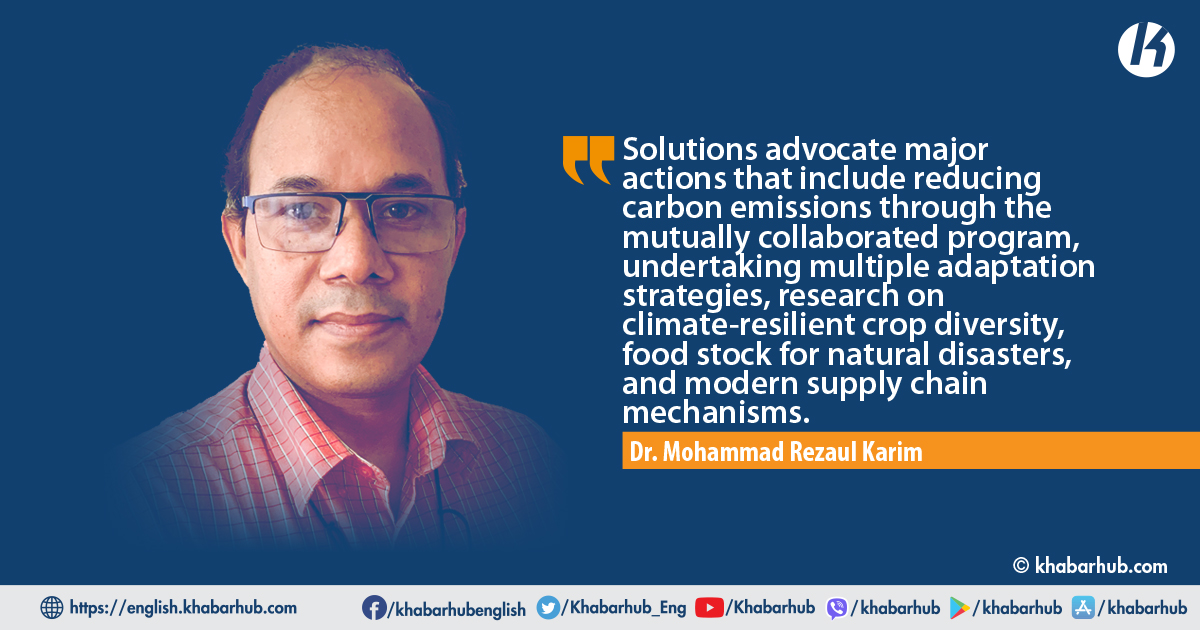The scientific community shows their great concern after witnessing the recent devastating floods in South Asia, wildfires in Europe, and increased temperatures around the world in addition to the COVID-19 pandemic and Ukraine crisis.
Whatever the adverse effects are noticed, are the results of climate change and human-induced interventions. Scientists are repeatedly emphasizing the issue and trying to draw attention and take stringent actions against world leaders.
These adversative effects did not happen in a day but rather came as a result of many years of injustice to the environment.
During the last three months from June to August 2022, persistent heatwaves affected several parts of Europe causing evacuations, heat-related deaths and adversities in food production.
Records regarding climate change effects set new records frequently breaking old ones. These new records surpass the intensity, severity in number and newness in dimensions.
As a result, mitigating mechanisms developed based on previous theories and systems cannot give the expected results.
As noticed, France has hit its highest recorded temperature of 45.9° Celsius amid a heatwave in Europe claiming several lives.
The UK has also the highest temperature which is 40.3°C, the hottest in about 100 years. Portugal is probably the worst-hit among the EU nations as it claimed the lives of 1063 people between July 7 and 18, 2022 because of the worst heatwave record of 47° Celsius in July this year.
It is estimated that the intense heatwave provoked wildfires and charred 45,467 hectares of land. Neighboring Spain also attributed 678 deaths to scorching temperatures across the country.
Agricultural researchers are continuously contributing to high-yielding food production over the last four decades by improving seeds, adopting climate-tolerant technologies, increase crop productivity.
Researchers comment that heat waves and extreme cold spells are closely associated with a decrease in general population well-being and an increase in mortality and morbidity, especially among vulnerable groups.
Data evidence that only heatwaves caused tens of thousands of premature deaths in Europe since 2000.
Although the projected cold-related mortality is decreasing owing to better social, economic, and housing conditions in many parts of Europe, the heatwave may lead to an increase again and vulnerable groups may encounter the effects again.
Understanding the trend of record-hit temperatures, it seems the cold European countries are likely to turn to tropical countries in recent times. Scientists are also afraid of intended adverse consequences that may happen in winter.
Climate change effects may decrease the temperature to a record as Europe has already witnessed the lowest temperature (-22,0°C in France on 21 December 2021). January 2022 is forecast to be colder with some cold blasts too.
While the whole of Europe is burning, other parts of the world are also facing a critical climate crisis at different levels and intensities of the problem.
Asia, Africa, and South America are affected by droughts. It is reported in the BBC news on 24 August that Europe’s drought seems to be the worst in 500 years with several famous European rivers having run dry.
A similar condition applies to some Chinese rivers and freshwater lakes that are running dry. It is also reported that the drought in the Horn of Africa has pushed more than 22 million people into starvation.
As per the report of the US Bureau of Reclamation, the two largest reservoirs in the US, Lake Mead and Lake Powell on the Colorado river have recorded the lowest level of water because of a 23-year prolonged drought.
Astonishingly, this lowest-level reservoir is the result of the manmade Hoover Dam built in the 1930s that stopped the flow of the Colorado river.
Asia probably notices the most vulnerable situation including the worst temperature in Summer, the lowest in winter and prolonged floods.
Pakistan is currently facing its most tragic climate effects because one-third of the country is inundated and at least 1136 people have died since the monsoon season began in June.
Rain also hits record in Soul wreaking the normal life that people did not see before. Weather officials of Korea estimated nearly 17 inches of rainfall in Southern Seoul in two days (8 & 9 August 2022) causing at least 9 deaths and evacuation of 800 residents to schools and gyms.
The manmade Farakka Barrage devastatingly affects Bangladesh by transforming to drought in the area and drying out the main river the Padma.
In addition to the previous experience of floods, Bangladesh is severely attacked by flash floods leaving the one-tenth population in danger.
The recent flash flood hit Sylhet Division and saw the loss of huge economic damage amounting to 1100 crore taka. People encountered untold suffering because of repeated floods and excessive rainfall in the area.
It is estimated that glaciers in the Himalayas lost billions of tons of ice between 2000 and 2016, double the amount that took place in 25 years between 1975 and 2000.
Unexpected behavior of weather in the region because of climate change brings a multiplicity of problems. Bangladesh Agricultural Research Council forecasts that there is a possibility of a 3.6 million tons rice gap in Bangladesh in 2030 due to the climate crisis which has already started from the current year as ongoing Aman plantation faces squeeze due to a record low rainfall and a surge in fertilizer and diesel price.
The Climate crisis will also affect the production of wheat, onion, potato, and maize which are the necessary items for addressing food culture in Bangladesh.
The demand is usually met by the import but that would not meet the expected demand because of a shortfall of production.
Agricultural researchers are continuously contributing to high-yielding food production over the last four decades by improving seeds, adopting climate-tolerant technologies, increase crop productivity.
However, climate change has adverse effects prolonging the food crisis, agricultural productivity and livelihood.
The Himalayan region is home to over 50 million people, yet an estimated 2 billion people rely on waters from Himalayan glaciers for drinking, energy, agriculture and more.
There are 32392 glaciers in the Himalayas that started melting due to the rise of global temperature and wreaking the livelihood of the huge populace of the region, particularly Pakistan, India and Bangladesh.
In order to save our planet and make it livable for people, we must realize the science of climate change; must adopt solutions as effective measures and ensure solidarity among the countries.
It is estimated that glaciers in the Himalayas lost billions of tons of ice between 2000 and 2016, double the amount that took place in 25 years between 1975 and 2000.
These glaciers have potential impacts of increasing flood, extreme weather events, changes in the monsoon, lowering agriculture yields, changes in energy production, and health hazards with a new variant of viruses.
Climate change effect results in global warming and creates a new record. Although carbon in the atmosphere from fossil fuel burning is not the only problem of global warming, the increasing concentration of greenhouse gas (GHG) and other human emissions are scientifically found proven as the main cause of increasing temperature.
This concentration wreaks the natural order of the world threatening lives, economies, health and food. Researches evidence that the concentration of human-caused carbon pollution in our atmosphere has nearly doubled in 60 years and it is continuing to escalate at a faster speed.
This makes humans liable for the devasting effect of climate change. Apart from the droughts and their multiple effects, rising temperature is the potential cause of sea-level rise as a result of melting ice.
Ice losses soared from a whopping 760 billion tons in the 1990s to more than 1.2 trillion tons in the 2010s from the thin ice shield covering most of the Arctic Ocean to the mile-thick mantle of the polar ice sheets.
Solutions advocate major actions that include reducing carbon emissions through the mutually collaborated program, undertaking multiple adaptation strategies, research on climate-resilient crop diversity, food stock for natural disasters and modern supply chain mechanisms.
Study shows that this increase amounts to more than 60 percent in twenty years. And ice is melting every year significantly due to global warming which means 24,000 tons of melting water are being added to the world’s oceans every single second contributing to sea-level rise.
This rise threatens the homes of millions of people around the world in low-lying territories.
In order to save our planet and make it livable for people, we must realize the science of climate change; must adopt solutions as effective measures and ensure solidarity among the countries.
The world is far from securing the global temperature rise to below 2 degrees Celsius, preferably 1.5 compared to the pre-industrial level and depleting 30 gigatonnes of GHS emissions annually by 2030 as promised in the Paris Agreement in 2015.
The science of climate change predicts the vulnerability of human civilization and the extinction of several species.
Solidarity may come through understanding and ensuring people’s right to life, right to health, right to housing and right to water and sanitation.
We should not forget whoever is the most responsible for climate change, everybody, even a child to be born tomorrow, is the worst victim.
Solutions advocate major actions that include reducing carbon emissions through the mutually collaborated program, undertaking multiple adaptation strategies, research on climate-resilient crop diversity, food stock for natural disasters and modern supply chain mechanisms.









Comment